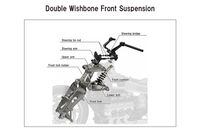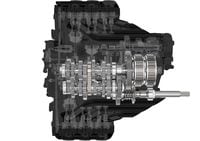Back in the 1970s and ’80s, a high-level transfer of Formula 1 technology to motorcycling seemed imminent as a flood of alternatives to the telescopic fork were proclaimed as the future. Didn’t happen.
What has happened is that, as rumored, Honda has put a double A-arm strut front suspension on the 2018 Gold Wing. It is said to accomplish several things:
- Eliminates the sliding stiction of a telefork, reducing transmission of shock from road surface to handlebar by 30 percent. Although Honda's wording is unclear, it seems to say that rolling bearings are used at the A-arm pivots and steering head to reduce both suspension and steering friction.
- Because the A-arm suspension allows mainly vertical movement of the front wheel, rather than the diagonal up-and-to-the-rear movement of a telefork, it has made possible moving the engine forward, allowing rider position to move ahead 36mm.
- Also claimed is a 40 percent reduction in steered mass. This tends to increase stability. The two A-arms project forward from the upper front of the motorcycle's frame to carry between them a pair of large-diameter steering-head bearings. A forked strut connects to the front axle at both its ends at the bottom and in tubular form passes up through the steering-head bearings. A linkage above the top steering bearing connects to the handlebars, which are pivoted on their own bearings a short distance to the rear.
It will be interesting to see whether in the future this suspension concept is adopted on other Honda models.


/cloudfront-us-east-1.images.arcpublishing.com/octane/MJVURQZODVFIFEH7CYR7CM4GPQ.jpg)
/cloudfront-us-east-1.images.arcpublishing.com/octane/NZKPFUWBHVGYJAFQPCXWAK6BZM.jpg)
/cloudfront-us-east-1.images.arcpublishing.com/octane/K5ZSQFMYQZHWRFXTTW4PEWMUDM.jpg)
/cloudfront-us-east-1.images.arcpublishing.com/octane/D2SOSBIQQRBPTERNSOJRAW3KYY.jpg)
/cloudfront-us-east-1.images.arcpublishing.com/octane/DS3Q5X2VJFFAJDK2PWB3Y7K6U4.jpg)
/cloudfront-us-east-1.images.arcpublishing.com/octane/4KBL4JAMYRFDPEINTWATDUH7OM.jpg)
/cloudfront-us-east-1.images.arcpublishing.com/octane/FXADK3MVSNBRTKJ2B7TPDCCJ5Y.jpg)
/cloudfront-us-east-1.images.arcpublishing.com/octane/M7L2CPXO55FRFMECW7QGDPGP6E.jpg)
/cloudfront-us-east-1.images.arcpublishing.com/octane/T4RWGLAEHVE2VCJZOTFTNGB2KA.jpg)
/cloudfront-us-east-1.images.arcpublishing.com/octane/BGPNXPDDYBHD3HL6YEZQOYHXTI.jpg)
/cloudfront-us-east-1.images.arcpublishing.com/octane/SND5GGQV4RDPPMZBSBEGIZ4SIY.jpg)
/cloudfront-us-east-1.images.arcpublishing.com/octane/XUDDAPYZMZEL5EDPVDJ2DTULWI.jpg)
/cloudfront-us-east-1.images.arcpublishing.com/octane/M7AU2L6GAVCJVHW57LIRPDAAUQ.jpg)

/cloudfront-us-east-1.images.arcpublishing.com/octane/JKEJY7P43JGD5C5NJO2VJQJPUM.jpg)
/cloudfront-us-east-1.images.arcpublishing.com/octane/YROKYJYUQVGPHCEMPTGBWDQCKQ.jpg)
/cloudfront-us-east-1.images.arcpublishing.com/octane/QIHEYR66TZDAPCGMWHCWCBC4XA.jpg)
/cloudfront-us-east-1.images.arcpublishing.com/octane/4FTBMNZL5BD2ZHY62XXRHJW6PI.jpg)
/cloudfront-us-east-1.images.arcpublishing.com/octane/L2BHKRCEMFDF7O3S4REZXPDH2E.jpg)
/cloudfront-us-east-1.images.arcpublishing.com/octane/QHENIV3HMJCTTCXQ6O5YPTNRZ4.jpg)
/cloudfront-us-east-1.images.arcpublishing.com/octane/K3VNQBIAKVGIHIGBRG7QKJYLVI.jpg)
/cloudfront-us-east-1.images.arcpublishing.com/octane/HRU64QXT3NH2DJOFBVI53XIKCE.jpg)
/cloudfront-us-east-1.images.arcpublishing.com/octane/4C5HHSNJCVDZXPIJTCJBVTE2MU.jpg)
/cloudfront-us-east-1.images.arcpublishing.com/octane/HBKK2TCOCZFIBIVKLKZFF5NXLQ.jpg)